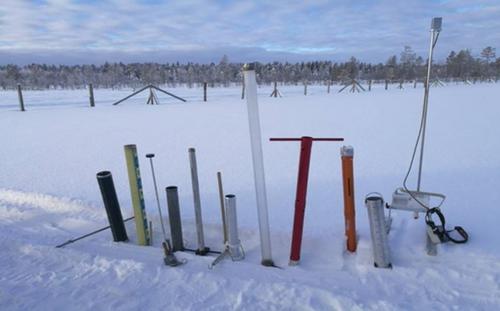当前位置:
X-MOL 学术
›
Hydrol. Process.
›
论文详情
Our official English website, www.x-mol.net, welcomes your
feedback! (Note: you will need to create a separate account there.)
Intercomparison of measurements of bulk snow density and water equivalent of snow cover with snow core samplers: Instrumental bias and variability induced by observers
Hydrological Processes ( IF 2.8 ) Pub Date : 2020-05-24 , DOI: 10.1002/hyp.13785 J. Ignacio López‐Moreno 1 , Leena Leppänen 2 , Bartłomiej Luks 3 , Ladislav Holko 4 , Ghislain Picard 5 , Alba Sanmiguel‐Vallelado 1 , Esteban Alonso‐González 1 , David C. Finger 6 , Ali N. Arslan 2 , Katalin Gillemot 7 , Aynur Sensoy 8 , Arda Sorman 8 , M. Cansaran Ertaş 8 , Steven R. Fassnacht 9 , Charles Fierz 10 , Christoph Marty 10
Hydrological Processes ( IF 2.8 ) Pub Date : 2020-05-24 , DOI: 10.1002/hyp.13785 J. Ignacio López‐Moreno 1 , Leena Leppänen 2 , Bartłomiej Luks 3 , Ladislav Holko 4 , Ghislain Picard 5 , Alba Sanmiguel‐Vallelado 1 , Esteban Alonso‐González 1 , David C. Finger 6 , Ali N. Arslan 2 , Katalin Gillemot 7 , Aynur Sensoy 8 , Arda Sorman 8 , M. Cansaran Ertaş 8 , Steven R. Fassnacht 9 , Charles Fierz 10 , Christoph Marty 10
Affiliation

|
Manually collected snow data are often considered as ground truth for many applications such as climatological or hydrological studies. However, there are many sources of uncertainty that are not quantified in detail. For the determination of water equivalent of snow cover (SWE), different snow core samplers and scales are used, but they are all based on the same measurement principle. We conducted two field campaigns with 9 samplers commonly used in observational measurements and research in Europe and northern America to better quantify uncertainties when measuring depth, density and SWE with core samplers. During the first campaign, as a first approach to distinguish snow variability measured at the plot and at the point scale, repeated measurements were taken along two 20 m long snow pits. The results revealed a much higher variability of SWE at the plot scale (resulting from both natural variability and instrumental bias) compared to repeated measurements at the same spot (resulting mostly from error induced by observers or very small scale variability of snow depth). The exceptionally homogeneous snowpack found in the second campaign permitted to almost neglect the natural variability of the snowpack properties and focus on the separation between instrumental bias and error induced by observers. Reported uncertainties refer to a shallow, homogeneous tundra‐taiga snowpack less than 1 m deep (loose, mostly recrystallised snow and no wind impact). Under such measurement conditions, the uncertainty in bulk snow density estimation is about 5% for an individual instrument and is close to 10% among different instruments. Results confirmed that instrumental bias exceeded both the natural variability and the error induced by observers, even in the case when observers were not familiar with a given snow core sampler.
中文翻译:

用积雪芯采样器测量积雪密度和积雪的水当量的比较:观测者引起的仪器偏差和变异性
手动收集的积雪数据通常被认为是许多应用(如气候学或水文研究)的基础。但是,有许多不确定性来源尚未详细量化。为了确定积雪(SWE)的水当量,使用了不同的雪芯采样器和天平,但是它们均基于相同的测量原理。我们对9个采样器进行了两次野外活动,这些采样器通常用于欧洲和北美洲的观测测量和研究,以更好地量化使用岩心采样器测量深度,密度和SWE时的不确定性。在第一个活动中,作为区分积雪和点规模测雪变化的第一种方法,沿着两个20 m长的雪坑进行了重复测量。结果表明,与在同一地点重复测量相比,在样地尺度上SWE的变化性更大(由自然变化和仪器偏差共同引起)(主要是由观察者引起的误差或雪深的极小尺度变化导致)。在第二次运动中发现的异常均匀的积雪几乎可以忽略积雪性质的自然变化,而将注意力集中在观察者引起的仪器偏差和误差之间。报告的不确定性是指深度小于1 m的浅而均匀的苔原带积雪(松散,大部分为重结晶雪,无风影响)。在这种测量条件下,单个仪器的大雪密度估算不确定度约为5%,而不同仪器之间的不确定度接近10%。
更新日期:2020-05-24
中文翻译:

用积雪芯采样器测量积雪密度和积雪的水当量的比较:观测者引起的仪器偏差和变异性
手动收集的积雪数据通常被认为是许多应用(如气候学或水文研究)的基础。但是,有许多不确定性来源尚未详细量化。为了确定积雪(SWE)的水当量,使用了不同的雪芯采样器和天平,但是它们均基于相同的测量原理。我们对9个采样器进行了两次野外活动,这些采样器通常用于欧洲和北美洲的观测测量和研究,以更好地量化使用岩心采样器测量深度,密度和SWE时的不确定性。在第一个活动中,作为区分积雪和点规模测雪变化的第一种方法,沿着两个20 m长的雪坑进行了重复测量。结果表明,与在同一地点重复测量相比,在样地尺度上SWE的变化性更大(由自然变化和仪器偏差共同引起)(主要是由观察者引起的误差或雪深的极小尺度变化导致)。在第二次运动中发现的异常均匀的积雪几乎可以忽略积雪性质的自然变化,而将注意力集中在观察者引起的仪器偏差和误差之间。报告的不确定性是指深度小于1 m的浅而均匀的苔原带积雪(松散,大部分为重结晶雪,无风影响)。在这种测量条件下,单个仪器的大雪密度估算不确定度约为5%,而不同仪器之间的不确定度接近10%。









































 京公网安备 11010802027423号
京公网安备 11010802027423号